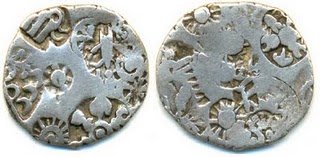FIGURES IN PUNCH MARK COINS
Various punches of animals, humans, mountains, rivers etc were punched on the punch mark coins on both the sides of the coin. Some of them are shown here.
THE BEGINNING
When did Coinage begun?
It started on both sides of the Ancient World - in China and in Lydia, in Asia Minor, at more or less the same time, about 700 years before Christ or 700 B.C. Coinage in INDIA begun about 6th century B.C. Many historians argue that Indian coinage existed prior to 6th century B.C in the Indus valley civilization of "Mohenjo-Daro and Harappa" between 2500 BC and 1750 BC. There, however, is no consensus on whether the seals excavated from the sites were in fact coins.
Seals found in Mohenjo-Daro
To the ancient Indians, a coin was not a piece of inanimate metal with an official stamp, but a form (rupa) pulsating with symbols, names of kings, gods and goddesses portraying wealth and prosperity. Each dynasty and even each king contributed his own innovation to the coinage resulting in a bewildering variety of Indian coins. The Kings chose such symbols, forms of gods and goddesses and legends which were a part of, social consciousness that the users of the coins could easily understand and appreciate.
The various symbols used on ancient punch mark coins are shown below:-
The establishment of Numismatic Society of India in 1910 is an important landmark in the study of Indian Coins.
PUNCH-MARK COINS
As the name suggests, these coins bear the symbols of various types, punched on pieces of silver of specific weight. Punch-marked coins are marked with 1-5 (and sometimes more) marks representing various symbols. They are broadly classified into two periods: the first period (attributed to the Janapadas or small local states) and the second period (attributed to the Imperial Mauryan period). The motifs found on these coins were mostly drawn from nature like the sun, various animal motifs, trees, hills etc. and some were geometrical symbols.
Ancient Indian coinage was based on `Karshapana' unit that consists of 32 rattis (3.3 grams of silver) and a 'Ratti' is equivalent to 0.11 gms.
 |
| Cup Shaped PMC Coins |
 |
| Silver Bent Bar Coins |
 |
| Multiple Punch Coins |
COINS OF JANAPADAS
Kuntala Janapadas 6th century BC, Silver, 6.24 g, pulley type with a big pulley-type symbol in the center and a clock-wise Triskeli in two of its orbs (Uniface)
Imperial Magadha 5th century BC, Silver, Karshapana, 5 symbols
Magadha: multiple punches seen
Vidarbha a square copper with three arched hills & crescent in a circle enclosed in a double square. 11.7 gms
Ancient copper coin with various symbols
JANAPADAS (OR) STATES
The silver punch mark coins have been found all over the country. The earliest of these were issued by janapadas and mahajanapadas which existed after the Bharat war (11th century B.C) .All these gradually merged with the expanding Magadha Empire by 4th century B.C. The states (janapadas) of which coins are known so far are:
(a) Surasena - Modern Braj, the region around Mathura
(b) Uttara Panchala - the Rohilkhand region
(c) Dakshin Panchala - the Doab area stretching from Ganga to
Chambal
(d) Chedi - the region south of Yamuna
(e) Kosala - the area bounded by Gomti on the west, Sarpika-modern
sai on the south, Sadanira-modern gandak on the east and Nepal hills on the north.
(f) Kasi- the region around Varanasi
(g) Malla - dist of Deoria and surroundings
(h) Magadha - area bound by Ganga on the north, Son on the west,
plateau of Chota Nagpur to the south and Bhagalpur region to the east.
(i) Vanga - Bengal
(j) Dakshina Kosala - western Orissa and eastern Madhya Pradesh
(k) Andhra - the delta of Godavari and Krishna
(l) Asmaka - area on both sides of Godavari bordering Andhra Pradesh
(m) Avanti - Ujjain region
(n) Surashtra - the Kathiawar region
(o) Gandhara - north western region on border of Afghanistan
(p) Kuntala - Satara region, western maharastra
 |
City of Taxila |
Observe: Three “Double Paddles” crossing a central circle. Two counter-marks:
Three dots within a circle, overlapping a sun, of which only a half is still visible.
Reverse: Blank
 |
Kingdom of Avanti |
Observe: Four Symbols.
Reverse: Blank
 |
Kingdom of Sunga |
Kingdom of Kasi
Observe: Two large and small punches.
Reverse: Four small punches of which only a windmill sail pattern is
recognizable.
 |
Mauryan Empire / Kingdom of Sunga |
 |
Mauryan Empire / Kingdom of Sunga |
 |
Mauryan Empire / Kingdom of Sunga |
 |
Mauryan Empire / Kingdom of Sunga |
 |
Mauryan Empire |
 |
Mauryan Empire / Kingdom of Sunga |
 |
Mauryan Empire / Kingdom of Sunga |
 |
Mauryan Empire / Kingdom of Sunga |
 |
Mauryan Empire / Kingdom of Sunga |
 |
Mauryan Empire / Kingdom of Sunga |
 |
Mauryan Empire / Kingdom of Sunga |
 |
Mauryan Empire / Kingdom of Sunga |
 |
Mauryan Empire / Kingdom of Sunga |
 |
Kingdom of Sunga |
 |
| Kingdom of Sunga |
 |
| Kingdom of Sunga |
 |
Modern Forgery Coin |
 |
Roman Coin – Augustus, 27 BC – Ad 14 (7.73 Gram – approx.) |















































































